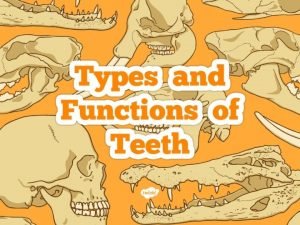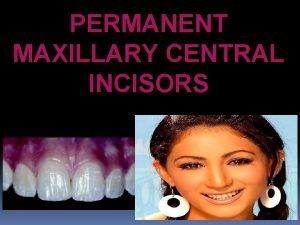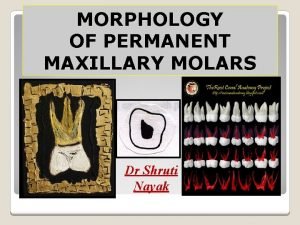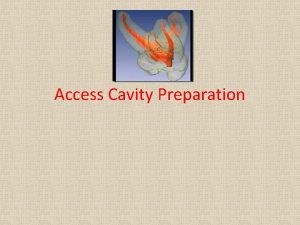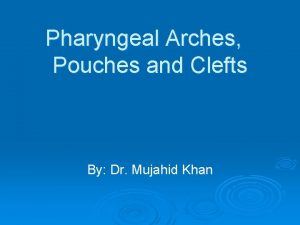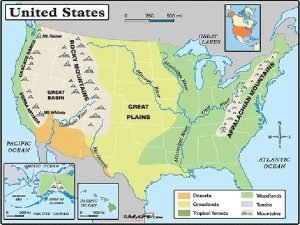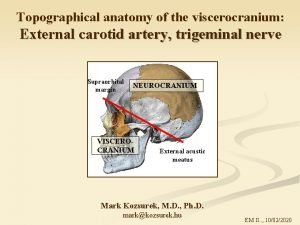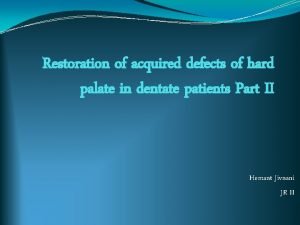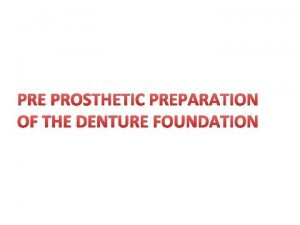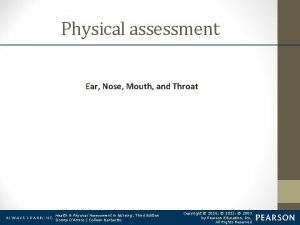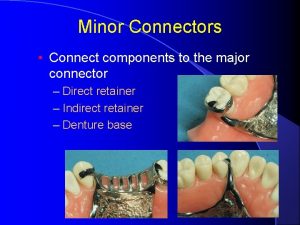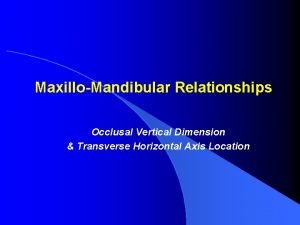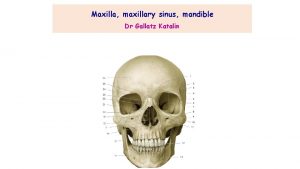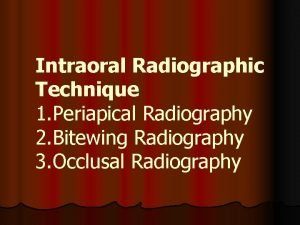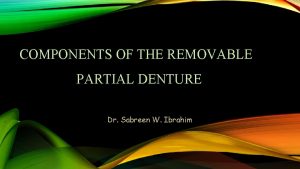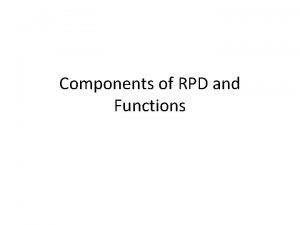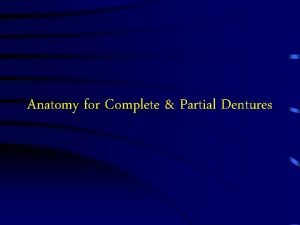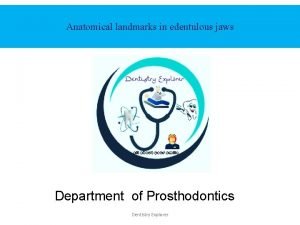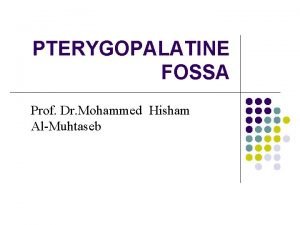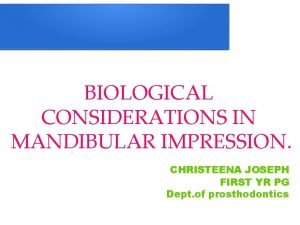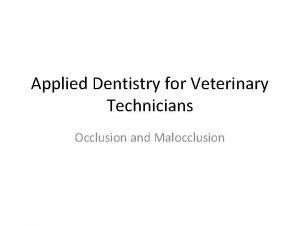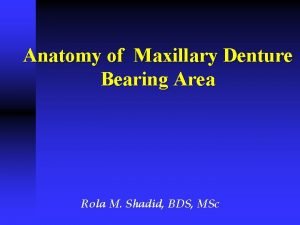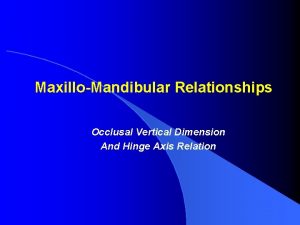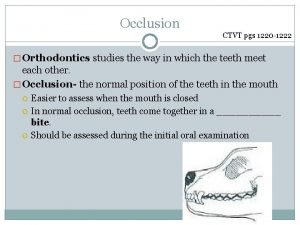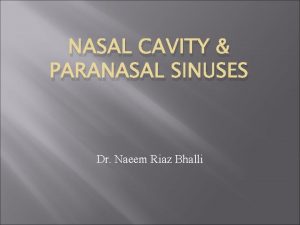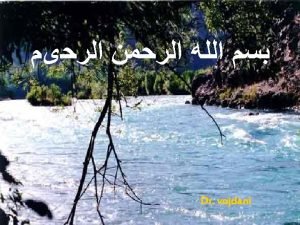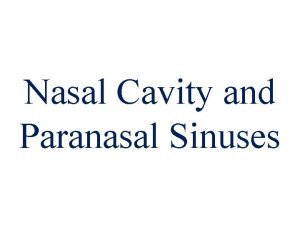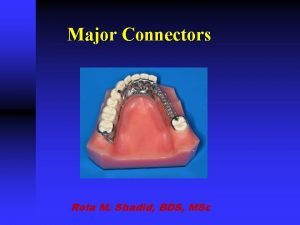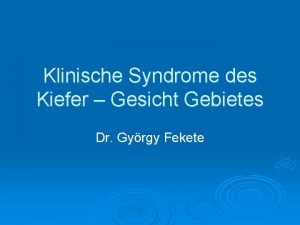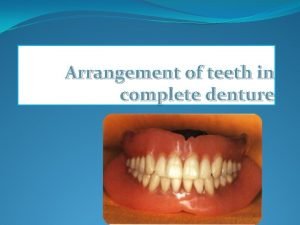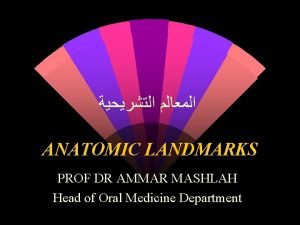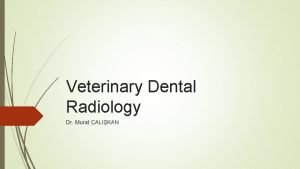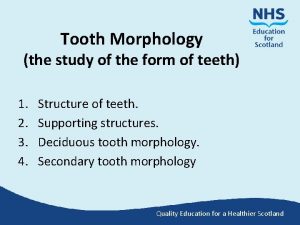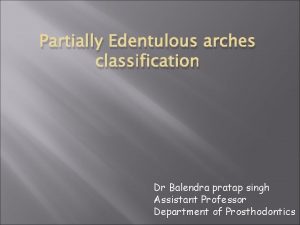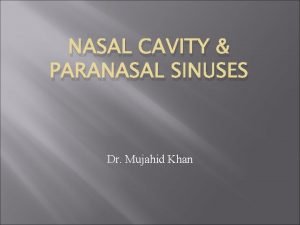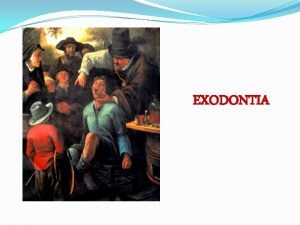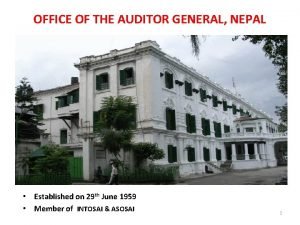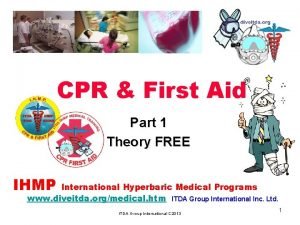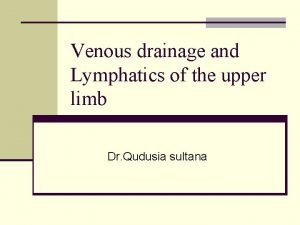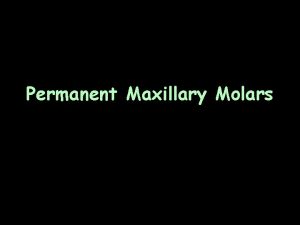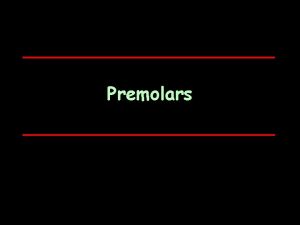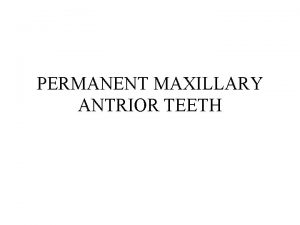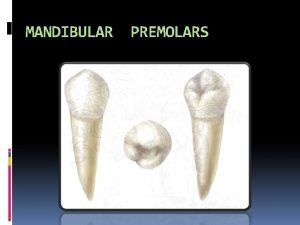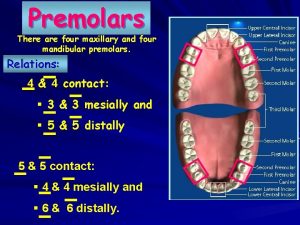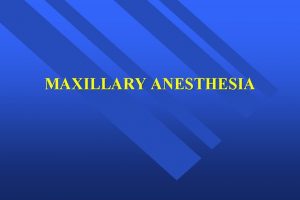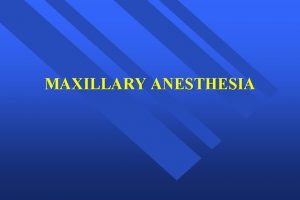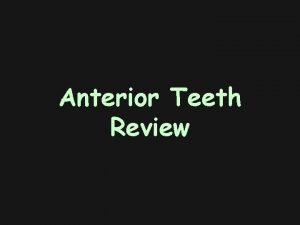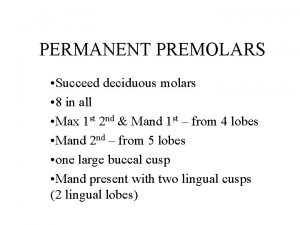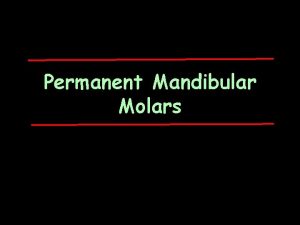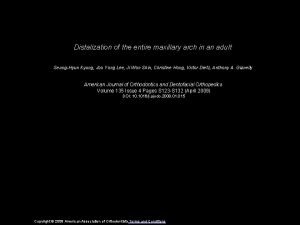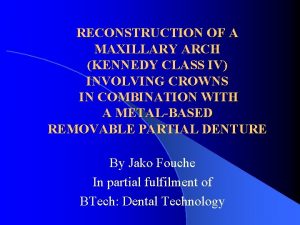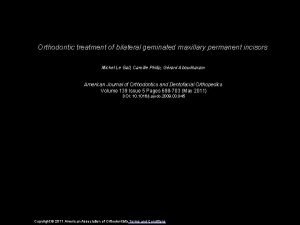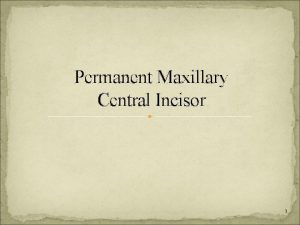Permanent Maxillary Premolars First Premolars General Characteristics Arch























































- Slides: 55

Permanent Maxillary Premolars First Premolars

General Characteristics: • Arch position: 4 th tooth from midline – Between the canine and 2 nd premolar • Universal #5 and # 12

General Form • Proximal geometric form is trapezoidal • Occlusally, resembles 6 -sided figure • Facially, similar to canine (5 -sided)

Form & Functions: • Two fairly equal cusps: facial and lingual • Presence of an occlusal table • Assists in tearing and piercing • Essentially a “grinding” tooth

Development Timeline: • Initial calcification: 1 1/2 to 1 3/4 years • Enamel completed: 5 - 6 years • Eruption: 10 - 11 years • Root completed: 12 - 13 years

Facial View • Closely resembles canine • Prominent buccal ridge with depressions on either side • Facial HOC at cervical third

Facial view, mesial outline: • Mesial HOC at junction of occlusal-middle thirds • Outline cervical to contact area slightly concave

Facial view, distal outline: • Similar to mesial outline • Less cervical concavity • HOC slightly more cervical than mesial

Facial view, occlusal outline: • Similar to canine except: • Cusp tip not as prominent • Cusp tip located just distal to midline of root* – Longer MB cusp ridge – Shorter DB cusp ridge *(unique)

Lingual View • Lingual narrower M-D than facial • Lingual cusp slightly shorter than facial (shortest of maxillary premolar cusps) • Lingual cusp offset to mesial • Lingual HOC at middle third

Mesial View • Trapezoidal geometric form • F and L cusps centered over root trunk • Mesial marginal groove visible

Mesial view. . . • Mesial concavity from root trunk to cervical portion of crown* • Mesial contact area facial to F-L midline

Distal View • Similar to mesial view except: • Shorter O-C than mesial – Distal marginal ridge more cervical – More of occlusal surface visible • No distinct distal concavity • Distal contact area slightly more cervical

Occlusal View • Outline is hexagon • Wider F-L than M-D • Outline tapers towards lingual • Lingual cusp offset to mesial • Mesial marginal ridge shorter than distal marginal ridge

Occlusal view. . . • Mesial outline indented by mesial marginal groove • M and D pits wellseparated • Less secondary grooves than 2 nd maxillary premolar

Occlusal view. . . • DB cusp ridge and distal marginal ridge angle is acute • MB cusp ridge and mesial marginal ridge angle is 90 o

Root Form • Single root (Type I) – Distinct mesial concavity – Cervical cross-section: kidney shape

Root form: • Bifurcated root (Type II) – Most common form – Short root trunk – Two roots: F and L, almost equal lengths

Root form: • Laminated root (Type III) – – Resembles Type II except: Longer root trunk F and L roots joined by lamination Mid-root cross-section: hour-glass shape

Root variations: • Trifurcation possible – 2 buccal roots and 1 lingual • Pulp canals: separate or connected • 2 pulp horns

How To Tell Right From Left: • • • Buccal cusp tipped distally* MB cusp ridge longer than DB* Mesial concavity* Lingual cusp tipped mesially* Mesial marginal groove*

Maxillary Second Premolar

General Characteristics: • Arch position: 5 th tooth from midline • Universal #4 and #13

Differences between 1 st and 2 nd: • Crown dimensions of 2 nd smaller than 1 st • 1 st more angular, 2 nd more rounded* • F and L cusps more equal in height with 2 nd*

Differences… • No mesial concavity or mesial marginal groove with 2 nd* • 2 nd normally single rooted • M and D pits closer together in 2 nd* • More supplemental grooves in 2 nd*

Developmental Timeline: • • Initial calcification: 2 - 2 1/4 years Enamel completed: 6 - 7 years Eruption: 11 - 12 years Root completed: 12 - 14 years

Facial View • Similar to 1 st except: – Buccal cusp of 2 nd not as long or pointed – Cusp tip mesial to root midline – MB cusp slope shorter than DB* – M and D contact areas slightly more cervical than 1 st

Lingual View • Similar to 1 st – Lingual cusp longer (equal to facial cusp) • Lingual cusp slightly offset to mesial

Mesial View • Similar to 1 st except: – – F and L cusps more equal height* No mesial concavity* Usually no mesial marginal groove Mesial contact area more cervical

Distal View • Similar to 1 st except: – F and L cusps more equal height – Distal contact area more cervical

Occlusal View • • • Line angles more rounded than 1 st* Central groove shorter* M and D pits closer together* More supplemental anatomy* M and D halves appear more symmetrical

Root Form • Usually single rooted (bifurcation rare but possible) • No deep mesial depression* • Root cross-section is ovoid

How To Tell Right From Left: • Lingual cusp tipped mesially* • MB cusp ridge shorter than DB • Root apex deviation usually towards distal

How To Tell 1 st from 2 nd: • 1 st usually bifurcated roots* • Occlusal outline of 1 st more angular, more rounded with 2 nd* • 1 st has mesial concavity*

1 st from 2 nd. . . • Central groove of 1 st longer • M and D pits of 1 st further apart* • MB cusp ridge of 1 st longer than DB (opposite with 2 nd) • Less supplemental grooves in 1 st

Tooth ID Test





Differences between 1 st and 2 nd: • Crown dimensions of 2 nd smaller than 1 st • 1 st more angular, 2 nd more rounded* • F and L cusps more equal in height with 2 nd*

Differences… • Buccal cusp tipped distally* • MB cusp ridge longer than DB* • Mesial concavity*

Differences… • No mesial concavity or mesial marginal groove with 2 nd* • 2 nd normally single rooted • M and D pits closer together in 2 nd* • More supplemental grooves in 2 nd*


Item 1 #9 Facial Mesial Lingual Occlusal Distal

Item 2 #5 Facial Mesial Lingual Occlusal Distal

Item 3 #5 Facial Mesial Lingual Occlusal Distal

Item 4 #26 Facial Mesial Lingual Occlusal/Incisal Distal

Item 5 #13 Facial Distal Lingual Occlusal Mesial

Item 6 #5 Facial Mesial Lingual Occlusal Distal

Item 7 #8 Facial Mesial Lingual Occlusal/Incisal Distal

Item 8 #11 Facial Mesial Lingual Occlusal/Incisal Distal

Item 9 #6 Facial Mesial Lingual Occlusal/Incisal Distal

Item 10 #22 Facial Mesial Lingual Occlusal/Incisal Distal

Item 11 #9 Facial Mesial Lingual Occlusal/Incisal Distal
 Difference between maxillary and mandibular premolars
Difference between maxillary and mandibular premolars Katz classification of premolars
Katz classification of premolars Premolars functions
Premolars functions Maxillary central incisor aspects
Maxillary central incisor aspects Maxillary 1st molar occlusal anatomy
Maxillary 1st molar occlusal anatomy Mandibular canine access opening
Mandibular canine access opening Parathyroid gland pharyngeal pouch
Parathyroid gland pharyngeal pouch 1st permanent english settlement
1st permanent english settlement Planos en cinematografia
Planos en cinematografia Where did general lee surrender to general grant?
Where did general lee surrender to general grant? Internal maxillary artery branches
Internal maxillary artery branches Brown classification of maxillary defects
Brown classification of maxillary defects Bony undercut
Bony undercut Palpate frontal and maxillary sinuses
Palpate frontal and maxillary sinuses Surface minor connector
Surface minor connector Maxillary anesthesia
Maxillary anesthesia Occlusion rim dimensions
Occlusion rim dimensions Maxillary artery division
Maxillary artery division Posterior surface of maxilla
Posterior surface of maxilla Horseshoe major connector indication
Horseshoe major connector indication Maxillary lateral occlusal projection
Maxillary lateral occlusal projection Cieszynski rule of isometry
Cieszynski rule of isometry Obwegeser vestibuloplasty
Obwegeser vestibuloplasty Beading of maxillary major connector
Beading of maxillary major connector Function of major connector
Function of major connector Denture bearing area
Denture bearing area Anatomical landmarks of complete denture
Anatomical landmarks of complete denture Pterygopalatine fossa
Pterygopalatine fossa Lower standard occlusal
Lower standard occlusal Lingual artery
Lingual artery G j mount classification of caries
G j mount classification of caries Retro mylohyoid fossa
Retro mylohyoid fossa Maxillary brachygnathism
Maxillary brachygnathism Stress bearing area of maxilla
Stress bearing area of maxilla Wax rim dimensions
Wax rim dimensions Mesioclusion definition
Mesioclusion definition Middle meatus
Middle meatus Nasal anatomy
Nasal anatomy Communication of nasal cavity
Communication of nasal cavity Wide palatal strap
Wide palatal strap Hallermann-streiff-syndrom bilder
Hallermann-streiff-syndrom bilder Bohns nodules
Bohns nodules Class 1 teeth arrangement
Class 1 teeth arrangement Oblique ridge of maxillary molar
Oblique ridge of maxillary molar Difference between maxillary and mandibular canine
Difference between maxillary and mandibular canine Tooth morphology is the study of
Tooth morphology is the study of Applegate rules
Applegate rules Mujahid nazal
Mujahid nazal Pyramidal eminence
Pyramidal eminence Potts elevator technique
Potts elevator technique Function of auditor general of nepal
Function of auditor general of nepal General first aid
General first aid The most dangerous game annotation answers
The most dangerous game annotation answers Arch drug and alcohol service
Arch drug and alcohol service Superficial veins of upper limb
Superficial veins of upper limb Lymphatic upper limb
Lymphatic upper limb


